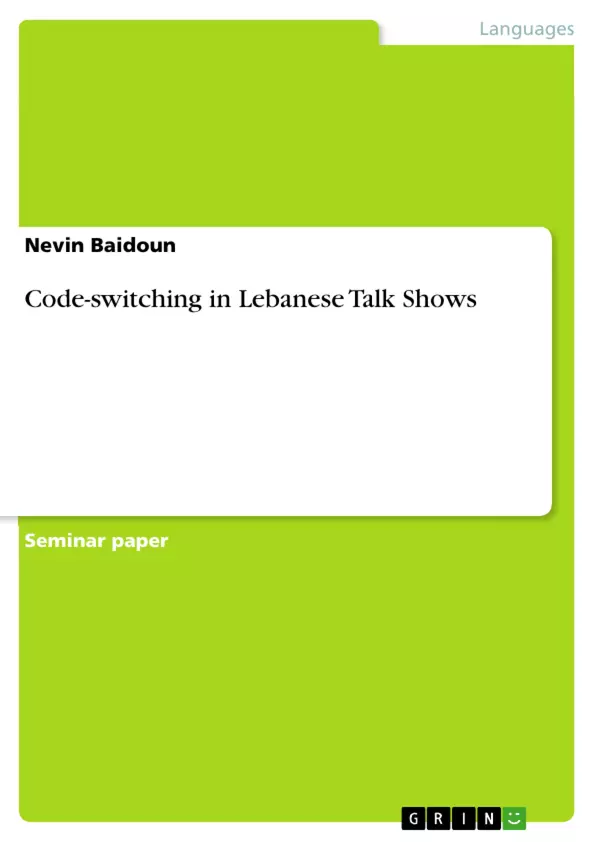Code-switching could thus be seen as one of the characteristics that defines life in Beirut, the capital of Lebanon, for visitors and its residents. Concerning two different episodes from a Lebanese talk show, the question posed in the given paper is whether, the topic of a conversation or speech influences the usage of code switching by Lebanese native speakers with regard to, for example, frequency or type of their code-switching. Therefore, I also want to look at why a speaker could do code-switching when talking about certain topics.
Arabic is the most widely spoken language by the six million inhabitants of Lebanon, as article 11 of its Constitution states, “Arabic is the official national language. A law determines the cases in which the French language may be used.” Due to the fact that Lebanon was under French rule during the first half of the 20th century (1918-1948), French is unsurprisingly used as a second language today. Nevertheless, since “English is seen as the language of business, technology and communications with the non-Arab world”, it is increasingly gaining status in Lebanon and especially among the younger generation. As a consequence, Arabic, French and English are frequently mixed in written and spoken language. When observing Lebanese television, it even seems as if the English-Arabic code-switching is steadily increasing a few years.
In contrast to the comparatively abundant research on code-switching between Arabic and English (or any other language), whereby the focus here is often on dialects from greater nations like Egypt, Algeria or Saudi-Arabia, research on code-switching between the dialect of the smallest Arabic nation Lebanon and English is rather limited. One of the reasons therefore could be the fact that English was only introduced to schools in Lebanon in the 21st century. The consequence for this is that Lebanon will still be associated with French as its lingua franca, although an increasing number of Lebanese people are speaking English.
Inhaltsverzeichnis (Table of Contents)
- Introduction
- Code-switching: theoretical background
- Lebanon's history of language
- Definition of code-switching
- The Markedness Model by Carol Myers-Scotton (1993) and the Communication Accommodation Theory by Howard Giles
- Linguistic variable
- Previous findings
- Methodology
- Analysis and results
- Discussion
- Conclusion
Zielsetzung und Themenschwerpunkte (Objectives and Key Themes)
This paper examines the phenomenon of English-Arabic code-switching in Lebanese talk shows, focusing on the use of code-switching by Lebanese native speakers. The aim is to investigate whether the topic of conversation influences the frequency and type of code-switching employed. The paper also explores the reasons behind code-switching in specific conversational contexts.
- Code-switching in Lebanese talk shows
- Influence of topic on code-switching
- Linguistic and socio-cultural factors driving code-switching
- The role of English as a second language in Lebanon
- Comparative analysis of code-switching in different Arabic dialects
Zusammenfassung der Kapitel (Chapter Summaries)
- Introduction: This chapter provides an overview of the context for code-switching in Lebanon, highlighting the linguistic landscape of the country and the increasing role of English. The study focuses on the talk show "Lahon w bas" and aims to investigate how topic influences code-switching patterns.
- Code-switching: theoretical background: This chapter presents a historical overview of language development in Lebanon, starting with the Phoenician language and culminating with the influence of French and English. The chapter then defines code-switching, discussing various theoretical frameworks such as the Markedness Model and the Communication Accommodation Theory.
- Methodology: This chapter outlines the research methods used in the study, including the specific episodes analyzed and the data collection and analysis procedures.
- Analysis and results: This chapter presents the results of the analysis, focusing on the frequency and type of code-switching observed in the selected talk show episodes.
- Discussion: This chapter discusses the findings and their implications, exploring the factors that drive code-switching in Lebanese talk shows and comparing them to previous research on code-switching in Arabic dialects.
Schlüsselwörter (Keywords)
This paper focuses on the key concepts of code-switching, bilingualism, Lebanese Arabic, English as a second language, talk shows, linguistic variation, communication accommodation theory, and sociolinguistics.
- Quote paper
- Nevin Baidoun (Author), 2018, Code-switching in Lebanese Talk Shows, Munich, GRIN Verlag, https://www.grin.com/document/1042136



